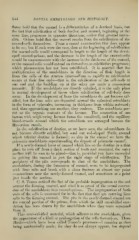Page 634 - My FlipBook
P. 634
644 DENTAL EMBRYOLOGY AND HISTOLOGY. ;;
Some hold that the enamel is a differentiation of a dentinal basis, but
the fact that calcification of both dentine and enamel, beginning at the
same line, progresses in opposite directions, makes that ground unten-
able. Others hold that the enamel results from the calcification of the
enamel-cells themselves. From a casual examination this does appear
to be so ; but if such were the case, then at the beginning of calcification
the enamel-cells would correspond in length to the length of the devel-
oped enamel-prisms, and the decrease in the length of the enamel-cells
would be commensurate with the increase in the thickness of the enamel,
or the enamel-cells would extend on themselves as calcifiation progresses
which phenomenon has not been established. It is asserted that the
multiplication of the ameloblasts in the direction of their length is
from the cells of the stratum intermedium as rapidly as calcification
occurs at their free ends—that is, the calcification of the cell-body at
one end and the building up at the other are made a consequent
necessity. If the ameloblasts are directly calcified, it is the only place
in normal development of tissue where calcification of cell-body does
occur. In the development of bone the osteoblasts do not become cal-
cified, but the lime salts are de})osited around the spherical osteoblasts
in the form of spherules, increasing in thickness from within outward
and, thus approaching one another, they coalesce. The osteoblasts per-
sist as the organic contents of the lacunae. The connection of one
lacuna with neighboring lacunae forms the canaliculi, and the capillary
blood-vessels around which the osteoblasts are arranged become the
Haversian canals.
In the calcification of dentine, as we have seen, the odontoblasts do
not become directly calcified, but send out rod-shaped fibrils, around
which tubular dentine is formed ; so also in the enamel we have the
prismatic ameloblasts superintending the deposit of prismatic enamel.
If a newly-formed la^^er of enamel which lies on the dentine in a thin
plate be torn off from a thick section of tooth and mounted, the outer
surface will be seen to be pitted—that is, provided you have succeeded
in getting the enamel in just the right stage of calcification. The
periphery of the pits corresponds to that of the ameloblasts. The
ameloblasts, during the formation of enamel, seem to be impregnated
with lime salts and break with a clean fracture at almost any point
—sometimes near the newly-formed enamel, and sometimes at a point
just inside the nucleus.
C S. Tomes noticed the fact of the probable impregnation at the end
nearest the forming enamel, and cited it as proof of the actual conver-
sion of the ameloblasts into enamel-prisms. The impregnation of both
ends of the cells is accounted for in the fact that they are carrying lime
salts to the forming enamel. The pits in the newly-formed enamel are
the central portion of the prisms, from which the still uncalcified exu-
dation has been drawn by the ameloblasts when they were separated
from it.
This semi-calcified material, which adheres to the ameloblasts, gives
the appearance of a fibril or prolongation of the cells themselves. These
fibrils—which have been called Tomes's processes—I consider as thus
being mechanically made ; for they do not always appear, but depend


